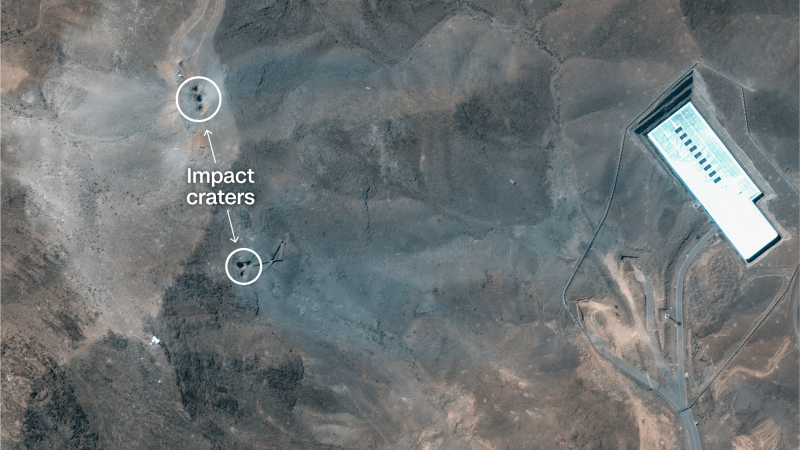
In a dramatic escalation of tensions, the United States launched a series of military strikes against Iran’s nuclear facilities on Saturday night. The operation, which involved warplanes, submarines, and cruise missiles, targeted three key sites in Iran’s nuclear program. President Donald Trump declared that Iran’s nuclear capabilities had been “obliterated,” a claim met with skepticism by Iranian officials.
The strikes represent a significant shift from the Trump administration’s earlier preference for diplomacy. With satellite imagery now emerging, the extent of the damage inflicted by the US is becoming clearer. Here’s a detailed look at the impact on Iran’s nuclear facilities.
Fordow: The Heart of Iran’s Nuclear Enrichment
Fordow, Iran’s most fortified nuclear enrichment facility, is strategically buried deep within a mountain to protect it from aerial attacks. The main halls are located approximately 80 to 90 meters underground. The US employed six B-2 bombers to deliver 12 massive, 30,000-pound GBU-57 bunker-busting bombs on this site.
According to satellite images analyzed by CNN, the strikes created at least six large craters at Fordow, indicating the use of these powerful munitions. Maxar Technologies provided these images, which show the craters along a ridge above the underground complex.
Rafael Grossi, head of the International Atomic Energy Agency (IAEA), confirmed a “direct kinetic impact” on Fordow. However, he cautioned that it was too early to determine the extent of internal damage.
“Of course, one cannot exclude the possibility that there is significant damage there,” Grossi stated.
David Albright, president of the Institute for Science and International Security (ISIS), suggested that the imagery indicates considerable damage to the enrichment hall and adjacent support areas.
“Total destruction of the underground hall is quite possible,” Albright noted, though he emphasized that a full assessment will take time.
Meanwhile, Iranian officials have downplayed the damage. Manan Raeisi, a lawmaker from Qom, described the impact as “quite superficial.” However, Albright advised skepticism towards such statements, citing Iran’s history of minimizing damage in past conflicts.
Natanz: A Key Target in the Nuclear Program
Natanz, Iran’s largest nuclear enrichment center, was initially targeted by Israel on June 13. The site comprises six above-ground buildings and three underground structures housing centrifuges essential for nuclear enrichment.
The recent US strikes involved a B-2 bomber dropping two bunker-busting bombs on Natanz, complemented by 30 Tomahawk cruise missiles launched from US Navy submarines. Satellite imagery revealed two new craters at the site, likely from the bunker-busting bombs. These craters are positioned directly above the underground complex.
The IAEA previously reported that Israel’s strikes damaged electrical infrastructure, potentially affecting the centrifuges. The full extent of underground damage from the US strikes remains unclear.
Isfahan: The Center of Nuclear Research
Isfahan, home to Iran’s largest nuclear research complex, was also targeted in the US operation. The facility, supported by China and operational since 1984, employs around 3,000 scientists and is central to Iran’s nuclear ambitions.
Post-strike satellite imagery shows significant destruction, with at least 18 structures either destroyed or partially damaged. The site is visibly marked by rubble and blackened terrain.
Albright suggested that the US targeted tunnel complexes near Isfahan, where enriched uranium is stored. If confirmed, this indicates an attempt to eliminate Iran’s uranium stocks enriched to 20% and 60%. Weapons-grade uranium requires 90% enrichment.
During a Pentagon briefing, Gen. Dan Caine, Chairman of the Joint Chiefs of Staff, confirmed the use of Tomahawk missiles against Isfahan’s surface infrastructure.
Implications and Future Considerations
The US strikes on Iran’s nuclear facilities mark a significant escalation in the ongoing conflict between the two nations. The immediate impact on Iran’s nuclear capabilities remains uncertain, with full assessments pending further analysis.
This development raises questions about the future of US-Iran relations and the potential for further military engagements. The international community is closely monitoring the situation, with diplomatic efforts likely to play a crucial role in the coming weeks.
As more information becomes available, the world will be watching to see how both nations navigate this heightened tension and what steps will be taken to prevent further escalation.






